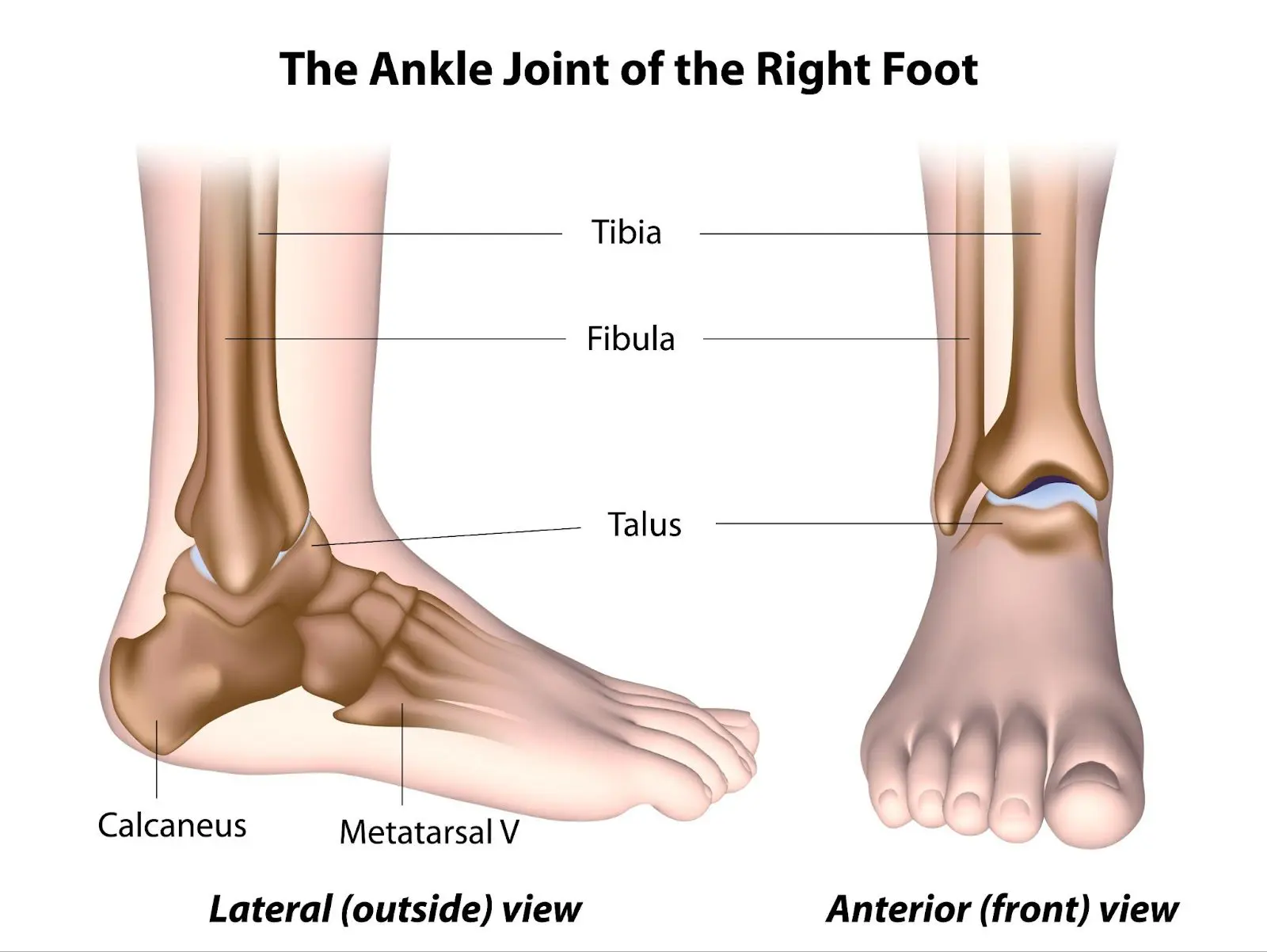When your ankle starts hurting after no injury occurs, it can often prompt you to ask yourself the question, “why does my ankle hurt for no reason?” In almost all cases, your ankle did not just start hurting out of nowhere and, although it can sometimes be an obvious reason, there is a reason for it nonetheless.
Ankle pain usually is the result of an injury, but it doesn’t have to be. Fractures and sprains are common injuries that cause ankle pain, but different levels of pain can also be a result of arthritis or even an underlying autoimmune condition. In this blog, we will explore the structure of the ankle, possible causes for ankle pain, and how to understand what to do when sudden ankle pain affects your life.
A Brief Look at the Structure of Your Ankle
The ankle is a very complex network of bones, ligaments, tendons, and muscles. The ankle joint is responsible for the up and down movement of our foot, while the subtalar joint handles the side-to-side movements. Those movements are made possible by the muscles and tendons that surround the ankle, and all the bones are stabilized by ligaments that hold them together.

There are two main joints of the ankle, the true ankle, and the subtalar joints. The true ankle or ‘upper ankle’ joint is composed of three bones: the tibia, the fibula, and the talus. The tibia forms the inside portion of the ankle, the fibula forms the outside portion of the ankle, and the talus forms the portion that is underneath. The true ankle joint is responsible for the horizontal up-and-down movement of the foot. Beneath the true ankle joint is the subtalar or ‘lower ankle’ joint which is responsible for allowing side-to-side motion of the foot. All of these components of the ankle work along with the muscles and tendons of your lower leg to handle the pressure and stress as you walk, run, and jump.
The various structures that make up the ankle work quite well together in enabling us to perform the many activities of our day-to-day lives. Still, they can be damaged amidst all their frequent use. Although we know you would like us to answer the question, “Why does my ankle hurt for no reason?” let’s first talk about some of the obvious causes of ankle pain with injury and how it can lead to ankle pain.
Common Causes of Ankle Pain With Injury
Ankle pain can be caused by a variety of reasons that vary in severity. Notoriously wobbly, injuries to the ankle account for 20 percent of all sports-related injuries, coming in at over 2 million injuries a year (AAFP). An impressive frequency, here’s a look at some of the most frequent causes of ankle pain.
Sprains and Strains
Sprains and strains are similar injuries to different body parts. A sprain is an injury to a ligament, which attaches bone to bone, and a strain is an injury to a muscle or a tendon, which attaches muscle to bone. The ankle is the most common location for these injuries, which can occur with increased activity, typically from running, jumping, landing, or pivoting incorrectly.
Bone Fractures
A bone fracture in the ankle is when any of its various bones break. Fractures can occur from a twisting injury or from direct trauma such as being kicked or having something heavy land on top of it. These breaks in the ankle range from a small crack in the bone, known as a hairline fracture, to compound fractures which are when broken bones pierce through the skin.
Arthritis
Arthritis, which can come in many different forms, is a term for a group of diseases that lead to inflammation in and around a joint. Over time the cartilage in the joint can wear down, causing the bones that meet in the joint to rub together, which leads to joint pain.
The most common form of arthritis is Osteoarthritis, oftentimes referred to as “degenerative joint disease”. This form of arthritis affects the joint slowly over many years. Other forms of arthritis include rheumatoid arthritis, a more severe arthritis caused by an autoimmune disease, and gout, a type of arthritis caused by a buildup of acid in your joints due to diet.
Common Causes & Conditions of Ankle Pain Without Injury
With all of the stress all the components of your ankle face on a day-to-day basis, ankle sprains, and injuries are common – but what happens when there is no obvious injury to pinpoint the pain to? If you’re experiencing symptoms of ankle pain such as swelling, redness, difficulty walking or balancing, bruising, stiffness, burning sensation, or even a tingling sensation, it’s important to rule out multiple conditions by a medical professional.
If an injury or physical activity is not the cause of your symptoms and pain, a number of other conditions can be responsible. To answer the question, why does my ankle hurt for no reason, we must first define the causes. Ankle pain can actually result in a variety of conditions from a wide spectrum of causes, including:
- Flat Feet. If there is no arch in your feet, the ankles can swell because they are no longer in alignment with your knees.
- Rheumatoid arthritis. A condition arising from excessive inflammation in the joints is commonly noticed if you experience ankle pain while running or doing other daily activities.
- Osteoarthritis. A condition where the cartilage between two joints wears down and the bones rub against each other causing sudden ankle pain.
- Achilles Tendinitis. A condition in which pain occurs in the back of the ankle where it develops small tears and the ankle feels tender, warm, or even slightly swollen.
- Lupus. An autoimmune disease that leads to inflammation and fluid build-up in your joints causing ankle pain.
- Gout. A condition where uric acid converts to sharp crystals in the joints of the feet and ankles causing intense swelling and pain.
- Infections. Different types of bacteria can build up and cause an infection and swelling in your ankle.
When to See a Doctor for Your Ankle Pain
Answering the question “Why does my ankle hurt for no reason?” can be frustrating when you don’t know where to seek help. Treatments for ankle pain differ depending on the nature and severity of the cause. However, it’s important to note that all Orthopaedic and orthopedic surgeons will explore non-surgery treatments before electing for surgery. Common forms of non-surgery treatment and therapy include:
- RICE — rest, ice, compression, elevation — a treatment easily done at home
- Physical Therapy, which can help to loosen and strengthen stiff and damaged joints.
- Immobilization of the joint, usually with a cast or a splint, is a common treatment for minor fractures and can help with sprains and strains as well.
If you’re not sure what is causing your ankle pain, it is so important to see a specialist to rule out more serious causes and conditions. For all forms of ankle pain, it’s best to consult an expert physician to find out the best form of treatment. Most strains will go away on their own, but because there is a chance ankle pain could be the underlying cause of a much more serious condition, it is important to see a doctor when you don’t know the direct cause.
Help for Your Ankle Pain No Matter the Severity
“So, what does it mean when my ankle starts hurting out of nowhere? And why does my ankle hurt for no reason?” Well, the short answer is there is always an underlying reason for ankle pain. There are, of course, many causes of ankle pain, so it’s important to reach out to a foot and ankle specialist for help. We understand how crucial healthy, properly functioning ankles are, and how burdensome ankle pain can be.
At Orthopaedic & Spine Center of the Rockies (OCR), we provide comprehensive, highly specialized podiatry care to residents of northern Colorado, Wyoming, and western Nebraska. We understand how crucial healthy, properly functioning ankles are, and how burdensome ankle pain can be. Our team of doctors has the knowledge that comes from years of experience focused on the diagnosis, treatment, and prevention of the full spectrum of ankle injuries and disorders. They’ll be able to examine your ankle and get to the bottom of any unexplainable pain you’re experiencing.
At Orthopeadic & Spine Center of the Rockies, that’s just what we’re passionate about – finding the source of and establishing a solution for your pain. If you’re experiencing ankle pain without a clear cause or injury, contact us today. We’re here to help you move like you used to.

